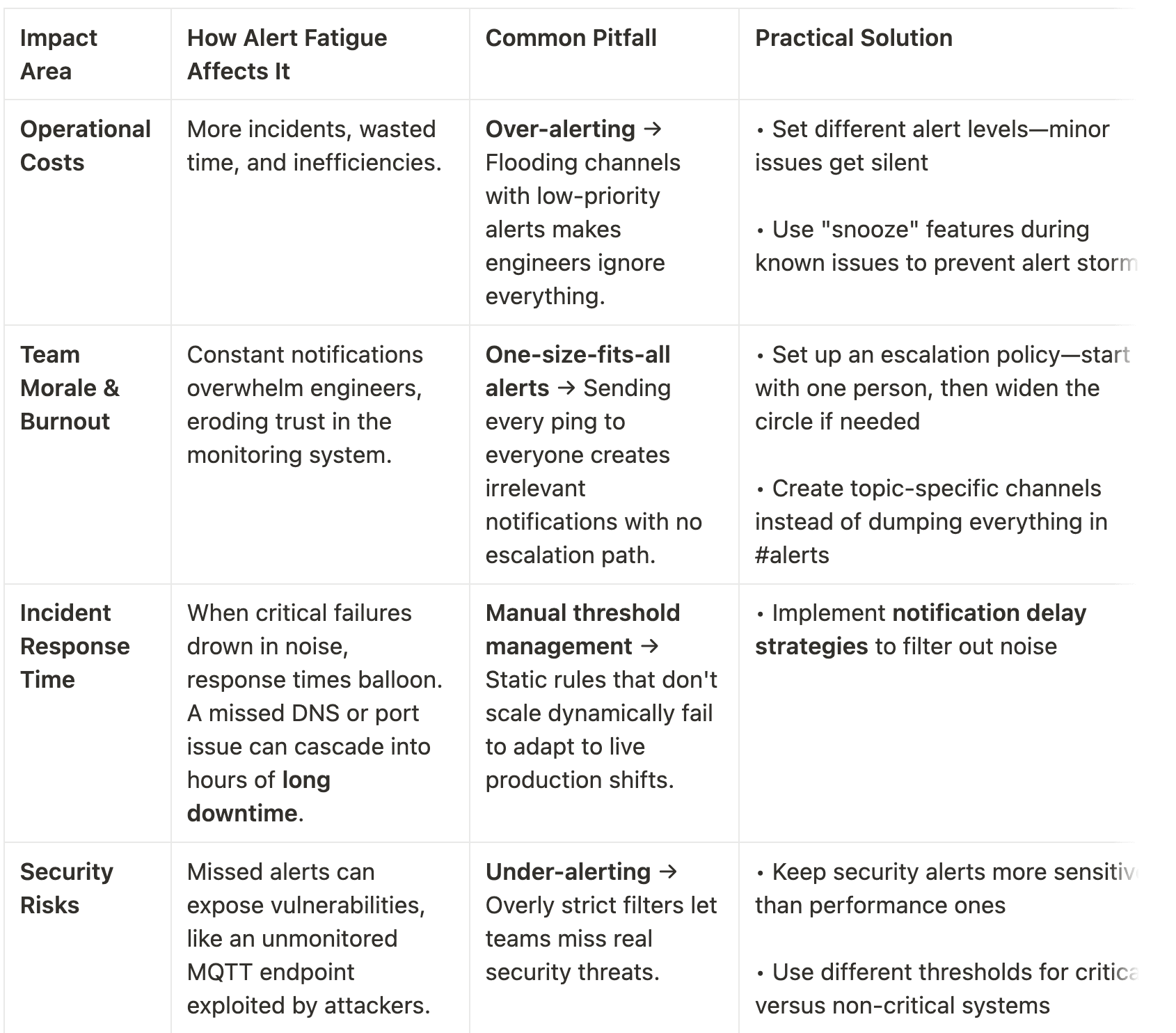How to Prevent Alert Fatigue with Notification Delay Strategies and Avoid Downtime
1. Introduction: The Alert Fatigue Crisis
Alert fatigue is real danger. The unending sound of notifications will eventually desensitize your team and cause the grid level mistakes like SSL expiry or Kafka issues to go unnoticed resulting in downtime, customer impact and revenue loss.
The table stakes are higher for SME. Every alert, with little IT expertise… needs attention. One critical alert would take away several hours downtime and hence, monitor uptime to keep the business running.
2. The Impact of Alert Fatigue & Common Pitfalls

📌 Pro Tip: To easily help with reducing fatigue, segment alerts into dedicated communication channels based on business impact. Route high-priority incidents affecting revenue to a "critical-alerts" Slack channel, while sending routine monitoring to separate channels. This simple channel strategy improves visibility of business-critical issues without additional tools or costs.
3. Best Practices for Preventing Alert Fatigue
The following best practices help companies boost uptime and keep teams sharp:
🔹 Service Classification & Prioritization
Briefly: Organize alerts by impact to focus on what matters most.
Tag alerts with criticality levels (e.g., P1, P2, P3) and define who needs to be notified—not every ping warrants waking the CTO. Bubobot's monitoring lets you prioritize HTTP, server, or Kafka alerts based on business needs, cutting noise effectively.
How Bubobot helps: Bubobot's escalation policy routes alerts to the right people based on severity, ensuring critical issues get immediate attention while routine notifications follow appropriate channels.
🔹 Smart Alert Routing & Notification Delay Strategies
Briefly: Deliver alerts smarter, not louder.
Use time-based notification delay strategies to filter fleeting glitches and route alerts based on team availability.
How Bubobot helps: Bubobot's Confirmation Period feature implements intelligent notification delay strategies that wait a specified time before sending alerts, automatically filtering out transient issues that resolve themselves. This approach significantly reduces alert noise while maintaining critical server uptime monitoring.
🔹 Alert Correlation & Grouping
Briefly: Consolidate alerts to reduce redundancy.
AI/ML tools can group related alerts—like a port failure tied to a DNS issue—into one actionable notification. Bubobot's anomaly detection correlates events, saving IT admins from alert storms.
How Bubobot helps: Bubobot allows users to groups related alerts from different services, presenting a unified view of the incident rather than multiple fragmented notifications.
🔹 Stakeholder Communication Strategies
Briefly: Align alerts with people and priorities.
Sync alert policies with on-call teams and business needs—e.g., escalate P1s instantly. Bubobot's escalation policy keep technical leaders in the loop without overwhelming them.
How Bubobot helps: Bubobot integrates with popular communication platforms, allowing customized alert delivery through email, SMS, Slack, or PagerDuty based on stakeholder preferences.
4. Conclusion
The risks of alert fatigue are extended downtime, increased costs and exasperation Bubobot: smart notification delays for AI powered uptime monitoring
Bubobot provides Smart Silencing features with rules of your context both static and dynamic.
- Focus: Cut through the noise and see only the alerts that truly matter to your business
- Efficiency: Spend less time flooding in alerts and more time fixing what's actually broken
- Peace of Mind: Rest easy knowing important issues won't get missed while false alerts are filtered out
- Effortless Adaptation: The system naturally aligns with your business priorities without manually constant tuning
Try now at https://bubobot.com/